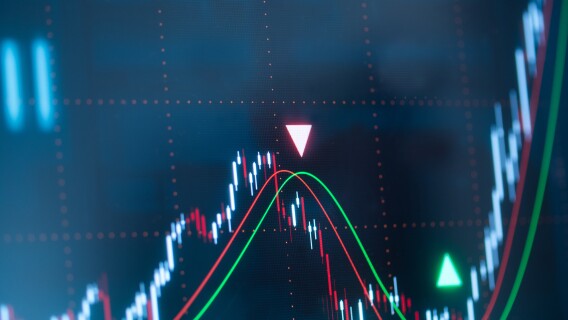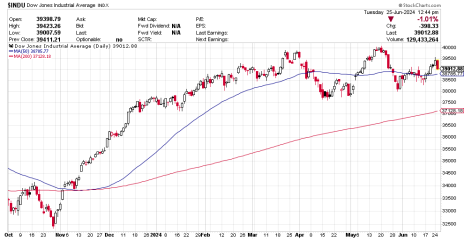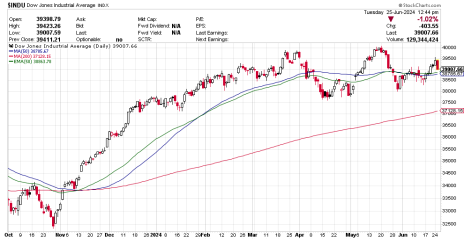If you’ve given any thought to technical analysis as part of your investing journey, you’ve undoubtedly come across references to moving averages. They’re frequently covered in the mainstream financial press, they’re a default setting on many charting tools, and we regularly use moving averages here at Cabot (both the Cabot Tides and the Cabot Trend Lines in Cabot Growth Investor rely on moving averages).
In fact, you may have read about the importance of the 200-day moving average on the pages of the Cabot Wealth Daily.
In the case of Cabot’s use of moving averages and default chart settings (at least for Yahoo! Finance or stockcharts.com, shown below), what you’re encountering are simple moving averages (SMAs).
What you may be less familiar with are exponential moving averages (EMAs), which use a different calculation than simple moving averages to give more weight to recent price movements. While SMAs are far more common, EMAs are used in a number of valuable studies and are sometimes preferred by high-paced traders. So, let’s break down SMAs vs. EMAs below.

Get My Free Report Now

Get My Free Report Now

Get My Free Report Now

Get My Free Report Now
Simple Moving Averages (SMAs) vs. Exponential Moving Averages (EMAs)
Simple Moving Averages (SMAs)
As you can see in the top left, the moving average line corresponds with “MA(number)” That means you’re seeing a moving average, with the number (in this case 50 or 200) representing the number of periods used to calculate the average.
MA(200) on a daily chart, would be a 200-day moving average. MA(200), on an hourly chart, would be a 200-hour moving average. This is why you’ll get different values if you change time periods on your charts. To see a 200-day moving average on a weekly chart, for instance, you’d use a 40-period (40 weeks x 5 days/week = 200 days) moving average.
The calculation is straightforward. For a 50-day moving average, the closing price for each of the last 50 days is added together and then divided by 50. When you reach a new day (day 51), the earliest value (day 1) drops off and the new day is added, but the denominator remains the same.
That’s why you’ll see an upward-sloping moving average line when a stock price is moving higher, and a downward-sloping line when a stock price is moving lower. But, the simplicity of that calculation also introduces something called “lag,” which is when a moving average is still heading higher while a stock price may have reversed course, or vice versa. If, for example, the closing price on day 51 is lower than day 50 (stock price headed lower) but still above the closing price of day 1, your moving average will keep heading higher because the day 1 value has been replaced with the higher day 51 value in the calculation.
You can see that at the end of October/beginning of November on the chart above when the Dow begins stringing together higher closes but the SMA keeps trending lower.
This lag isn’t all bad, it can help discount market noise and can keep you from getting knocked out of a promising stock because of short-term volatility, but it’s also why many day traders prefer to use EMAs for entry and exit points.
Exponential Moving Averages (EMAs)
The exponential moving average, on the other hand, uses slightly more complicated calculations to give more weight to recent price movements. This is done through the use of a “smoothing factor” (usually 2) that determines how much extra weight to give to the most recent close.
In a 50-day EMA with a smoothing factor of 2, the most recent close represents 3.9% of the total value of the EMA, and the other 49 days comprise the remaining 96.1%.
We won’t get into the math here, but a smoothing factor of 3 would give the most recent close a 5.9% weight on a 50-day EMA. The higher your smoothing factor, the closer you get to just replicating the price chart.
Because the EMA is calculated by adding the most recent day’s value (prior close x 3.9%) to the previous day’s modified EMA (yesterday’s EMA x 96.1%), that extra weight in the most recent days is “sticky” for lack of a better term (the day before the prior close is 3.9% of the 96.1% balance, or 3.75% of the total EMA). The end result is that an exponential moving average responds more quickly to price movements, as you can see below.
The EMA on that chart (green line) starts trending higher about a week before the SMA turns upward, all because it’s valuing the recent uptrend more highly. By that same token, a trader using EMA instead of the SMA would have gotten a “break” above the moving average a day earlier.
But it works the same way in either direction, which makes it more susceptible to false breakouts (or breakdowns).
The tradeoff, as with most indicators, is speed for stability. A faster signal from an EMA is more likely to be wrong than a slower signal from an SMA with the same period. The upside is you’re in and out quicker (more gains, fewer losses) but the downside is more false starts.
The most important takeaway is that the indicator you use should match your trading style and personal preferences. If you’re an intermediate- or long-term investor who wants to be aware of the technical picture (without necessarily trading off it), the SMA is the safer bet (plus, it’s the moving average you’re most likely to encounter in the media, on charts, etc.). If, on the other hand, you’re a high-frequency trader who’s regularly in and out of positions and looking for an edge to squeeze out a few more percentage points, the EMA may be the way to go.

Sign up now!

Sign up now!

Sign up now!

Sign up now!



